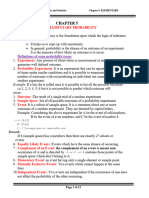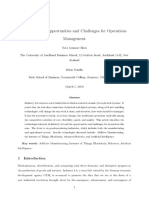Probability: Bùi Thị Lệ Thủy/
Probability: Bùi Thị Lệ Thủy/
Uploaded by
JennysanCopyright:
Available Formats
Probability: Bùi Thị Lệ Thủy/
Probability: Bùi Thị Lệ Thủy/
Uploaded by
JennysanOriginal Description:
Original Title
Copyright
Available Formats
Share this document
Did you find this document useful?
Is this content inappropriate?
Copyright:
Available Formats
Probability: Bùi Thị Lệ Thủy/
Probability: Bùi Thị Lệ Thủy/
Uploaded by
JennysanCopyright:
Available Formats
Bùi Thị Lệ Thủy
PROBABILITY
Bùi Thị Lệ Thủy\
1st Semester 2022
Probability
Chapter 1
COMBINATORIAL ANALYSIS
1. Introduction
2. The Basic Principle of Counting
3. Permutations
4. Combinations
5. Partitions
1st Semester 2022
Probability
1. Introduction
• Many problems in probability theory can be solved simply by
counting the number of different ways that a certain event can occur.
• The mathematical theory of counting is formally known as
combinatorial analysis.
1st Semester 2022
Probability
2. The Basic Principle of Counting
• Suppose that the outcomes of an experiment consist of a
combination of two separate tasks or actions. Suppose there are
n possibilities for the first task, and that for each of these n
possibilities there are k possible ways to perform the second
task. Then there are nk possible outcomes for the experiment
1st Semester 2022
Probability
2. The Basic Principle of Counting
Example 1.1: An employee of a southwestern state can choose one of
three group life insurance plans and one of five group health insurance
plans. Find the total number of ways she can choose her complete life
and health insurance package.
1st Semester 2022
Probability
2. The Basic Principle of Counting
Example 1.2: A small community consists of 10 women, each of whom
has 3 children. If one woman and one of her children are to be chosen
as mother and child of the year, how many different choices are
possible?
1st Semester 2022
Probability
2. The Basic Principle of Counting
The generalized basic principle of counting
• Suppose that the outcomes of an experiment consist of a
combination of k separate tasks or actions. If task i can be performed
in ni ways for each combined outcome of the remaining tasks for i = 1,
2, …k, then the total number of outcomes for the experiment is
n1 · n2 · · ·nk.
1st Semester 2022
Probability
2. The Basic Principle of Counting
Example 1.3: A college planning committee consists of 3 freshmen, 4
sophomores, 5 juniors, and 2 seniors. A subcommittee of 4, consisting
of 1 person from each class, is to be chosen. How many different
subcommittees are possible?
1st Semester 2022
Probability
2. The Basic Principle of Counting
Example 1.4:
(a) How many different 7-place license plates are possible if the first 3
places are to be occupied by letters (from 24 letters) and the final 4
by numbers?
(b) how many 7-place license plates would be possible if repetition
among letters or numbers were prohibited?
1st Semester 2022
Probability
3. Permutations
Question: How many different ordered arrangements of the letters a, b,
and c are possible?
Answer: abc, acb, bac, bca, cab, cba
Each arrangement is known as a permutation.
Suppose now that we have n objects. There are
n(n - 1)(n - 2) · · · 3 · 2 · 1 = n!
different permutations of the n objects.
1st Semester 2022
Probability
3. Permutations
Example 1.5: How many different batting orders are possible for a
baseball team consisting of 9 players?
1st Semester 2022
Probability
3. Permutations
Example 1.6: A class in probability theory consists of 6 men and 4
women. An examination is given, and the students are ranked
according to their performance. Assume that no two students obtain
the same score.
(a) How many different rankings are possible?
(b) If the men are ranked just among themselves and the women just
among themselves, how many different rankings are possible?
1st Semester 2022
Probability
3. Permutations
Example 1.7: Ms. Jones has 10 books that she is going to put on her
bookshelf. Of these, 4 are mathematics books, 3 are chemistry books, 2
are history books, and 1 is a language book. Ms. Jones wants to arrange
her books so that all the books dealing with the same subject are
together on the shelf. How many different arrangements are possible?
1st Semester 2022
Probability
3. Permutations
Example 1.8: How many different letter arrangements can be formed
from the letters PEPPER?
1st Semester 2022
Probability
3. Permutations
General Result
Suppose you have n objects. The number of different permutations of
these n objects of which n1 are alike, n2 are alike,..., nr are alike is given
by
𝑛! 𝑛
:= 𝑛 ,𝑛 ,…𝑛
𝑛1 !𝑛2 !…𝑛𝑟 ! 1 2 𝑟
1st Semester 2022
Probability
3. Permutations
Example 1.9: A chess tournament has 10 competitors, of which 4 are
Russian, 3 are from the United States, 2 are from Great Britain, and 1 is
from Brazil. If the tournament result lists just the nationalities of the
players in the order in which they placed, how many outcomes are
possible?
1st Semester 2022
Probability
3. Permutations
Example 1.10: How many different signals, each consisting of 9 flags
hung in a line, can be made from a set of 4 white flags, 3 red flags, and
2 blue flags if all flags of the same color are identical?
1st Semester 2022
Probability
4. Combinations
• We are often interested in determining the number of different
groups of r objects that could be formed from a total of n objects.
• n(n - 1) · · · (n - r + 1) represents the number of different ways that a
group of r items could be selected from n items when the order of
selection is relevant, and as each group of r items will be counted r!
times in this count, it follows that the number of different groups of r
items that could be formed from a set of n items is
n(n − 1) · · · (n − r + 1) n!
=
r! (n − r)! r!
1st Semester 2022
Probability
4. Combinations
Notation and terminology
𝑛
We define , for r ≤ 𝑛, by
𝑟
𝑛 n!
=
𝑟 (n − r)! r!
𝑛
and say that (read as "n choose r") represents the number of
𝑟
possible combinations of n objects taken r at a time.
1st Semester 2022
Probability
4. Combinations
Example 1.11: Assume we have an horse race with 12 horses. What is
the possible number of combinations of 3 horses when the order
matters and when it does not?
1st Semester 2022
Probability
4. Combinations
General Result
We want to determine the number of different groups of r objects
that could be formed from a total of n objects.
• When the order of selection is relevant, there are
n!
n(n − 1) · · · (n − r + 1) =
(n − r)!
• When the order of selection is irrelevant, there are
n! 𝑛
≔
(n − r)! r! 𝑟
1st Semester 2022
Probability
4. Combinations
Example 1.12: A committee of 3 is to be formed from a group of 20
people. How many different committees are possible?
1st Semester 2022
Probability
4. Combinations
Example 1.13: From a group of 5 women and 7 men, how many
different committees consisting of 2 women and 3 men can be formed?
What if 2 of the men are feuding and refuse to serve on the committee
together?
1st Semester 2022
Probability
5. Partitions
• A set of n distinct items is to be divided into r distinct groups of
respective sizes n1, n2, . .. , nr, where 𝑟𝑖=1 𝑛𝑖 = 𝑛. There are
𝑛! 𝑛
∶= 𝑛 , 𝑛 , … 𝑛
𝑛1 !𝑛2 !…𝑛𝑟 ! 1 2 𝑟
possible divisions.
1st Semester 2022
Probability
5. Partitions
Example 1.14: A police department in a small city consists of 10
officers. If the department policy is to have 5 of the officers patrolling
the streets, 2 of the officers working full time at the station, and 3 of
the officers on reserve at the station, how many different divisions of
the 10 officers into the 3 groups are possible?
1st Semester 2022
Probability
5. Partitions
Example 1.15: Ten children are to be divided into an A team and a B
team of 5 each. The A team will play in one league and the B team in
another. How many different divisions are possible?
1st Semester 2022
Probability
5. Partitions
Example 1.16: In order to play a game of basketball, 10 children at a
playground divide themselves into two teams of 5 each. How many
different divisions are possible?
1st Semester 2022
You might also like
- D218 - Task 2 - Brianna KnoxDocument4 pagesD218 - Task 2 - Brianna KnoxbriannakaraNo ratings yet
- Pscyho Cybernetics Book Maxwell MaltzDocument304 pagesPscyho Cybernetics Book Maxwell MaltzNur muhammad100% (23)
- 6.1 Permutations and Combinations + SolutionDocument36 pages6.1 Permutations and Combinations + SolutionJulianNo ratings yet
- Module 1: COUNTING TECHNIQUESDocument12 pagesModule 1: COUNTING TECHNIQUESrinobiNo ratings yet
- Chapter9 CountingDocument55 pagesChapter9 CountingChenxing ZhangNo ratings yet
- Lesson PlanDocument5 pagesLesson PlanKIMBERLY PANTORILLANo ratings yet
- CountingDocument8 pagesCountingnzoborNo ratings yet
- PNC HCI Lecture NotesDocument26 pagesPNC HCI Lecture Notes22S48 SUNDARAM RAMASUBBU RAKSHANo ratings yet
- Class - X Summer Assignment 2023-24Document2 pagesClass - X Summer Assignment 2023-24traxisxdNo ratings yet
- #Topic 5 Relations, Mapping and FunctionsDocument7 pages#Topic 5 Relations, Mapping and FunctionsjamesbriandunguNo ratings yet
- Problems Involving CombinationDocument5 pagesProblems Involving Combinationbanot10262002No ratings yet
- Math 2421 Probability TextbookDocument197 pagesMath 2421 Probability TextbookPik ki WongNo ratings yet
- Chapter_5_-_Basic_Concepts_of_Permutations_and_Combinations_471ee622-b973-4665-96e1-d258fcaf46ccDocument7 pagesChapter_5_-_Basic_Concepts_of_Permutations_and_Combinations_471ee622-b973-4665-96e1-d258fcaf46ccvijaychoudhary889830No ratings yet
- M6 2020 Permutations and Combinations Lecture Notes For SLSDocument38 pagesM6 2020 Permutations and Combinations Lecture Notes For SLScoyite8695No ratings yet
- Chapter-5-Elementary ProbabilityDocument10 pagesChapter-5-Elementary ProbabilityDelia AndreeaNo ratings yet
- Law of RadicalsDocument4 pagesLaw of RadicalsAmiel Marie M. CalpitoNo ratings yet
- Demo Lesson PlanDocument7 pagesDemo Lesson PlanRizrald AmolinoNo ratings yet
- Statistics chp7Document12 pagesStatistics chp7Tasebe GetachewNo ratings yet
- Self - Learning Material: Philsaga High School Foundation, IncDocument17 pagesSelf - Learning Material: Philsaga High School Foundation, IncLittle EpaiiNo ratings yet
- PROBSTATDocument3 pagesPROBSTATJerick Banzuelo CariagaNo ratings yet
- CH 5 and 6Document35 pagesCH 5 and 6zeyin mohammed aumer100% (2)
- Chapter 5. Elementary ProbabilityDocument11 pagesChapter 5. Elementary ProbabilityyonasNo ratings yet
- Lesson 1Document27 pagesLesson 1OzanNo ratings yet
- Mathematics7 - q2 - Clas5 - Laws-of-Exponents-Multiplication-and-Division-of-Polynomials - v5 (1) - JOSEPH AURELLODocument19 pagesMathematics7 - q2 - Clas5 - Laws-of-Exponents-Multiplication-and-Division-of-Polynomials - v5 (1) - JOSEPH AURELLORezza May Venturillo Orpilla100% (1)
- MP-Combinations ReportDocument5 pagesMP-Combinations ReportHarbs OrHarNo ratings yet
- Chapter Five NoteDocument11 pagesChapter Five Notekenenisa AbdisaNo ratings yet
- To Probability: CautionDocument27 pagesTo Probability: CautionCrystal MaxNo ratings yet
- Permutation Vs CombinationDocument26 pagesPermutation Vs CombinationJoan SullanoNo ratings yet
- Chapter 5 Elementary ProbabilityDocument12 pagesChapter 5 Elementary ProbabilityKebede HaileNo ratings yet
- Combinatorics: Applies To Whole Numbers, and N! Indicates That We Multiply Together All The NumbersDocument4 pagesCombinatorics: Applies To Whole Numbers, and N! Indicates That We Multiply Together All The NumbersSneha RNo ratings yet
- DLL-8 (Week 1, Day 5)Document9 pagesDLL-8 (Week 1, Day 5)MARISSA CUIZONNo ratings yet
- Chapter-5-Elementary ProbabilityDocument11 pagesChapter-5-Elementary ProbabilityAwwal EdrisNo ratings yet
- Lesson Exemplar in CombinationDocument5 pagesLesson Exemplar in CombinationIrish Vain Galindo100% (1)
- Factors and Multiples 1Document24 pagesFactors and Multiples 1Sanila SubhashNo ratings yet
- Bendicio, Hamia Vianney ODocument5 pagesBendicio, Hamia Vianney OHanna Vichelle BendicioNo ratings yet
- Bsa1c-Gec05-Problem SetDocument6 pagesBsa1c-Gec05-Problem SetgreinangeloNo ratings yet
- I. Objectives:: Emily L. AlonzoDocument7 pagesI. Objectives:: Emily L. AlonzoRussel PanuganNo ratings yet
- MMW - PPT3 Problem SolvingFirst2122Document32 pagesMMW - PPT3 Problem SolvingFirst2122Richville PenetranteNo ratings yet
- Lecture MainDocument140 pagesLecture MainWilly ChandraNo ratings yet
- Chapter 2 Elementary ProbabilityDocument11 pagesChapter 2 Elementary ProbabilitytasheebedaneNo ratings yet
- Sta416 3 2Document21 pagesSta416 3 2muhd.ajimmehNo ratings yet
- LAS Math10 Q3 Wk1 - Introduction-of-PermutationDocument8 pagesLAS Math10 Q3 Wk1 - Introduction-of-PermutationmilkNo ratings yet
- 1Document16 pages1pustudydiariesNo ratings yet
- Chapter 6.1 - Methods of CountingDocument21 pagesChapter 6.1 - Methods of CountingANo ratings yet
- Counting TechniquesDocument12 pagesCounting TechniquesKate NicoleNo ratings yet
- DLL-8 (Week 1, Day 5)Document8 pagesDLL-8 (Week 1, Day 5)Melvin ElliveraNo ratings yet
- Dll-8 (Week 1, Day 5)Document8 pagesDll-8 (Week 1, Day 5)Henel MarNo ratings yet
- LP1Document3 pagesLP1JJ Delegero BergadoNo ratings yet
- Explanation - Unit 4 Counting TechniquesDocument14 pagesExplanation - Unit 4 Counting TechniquesGhian Carlo Garcia CalibuyotNo ratings yet
- Curriculum Guide: (Taken From The)Document3 pagesCurriculum Guide: (Taken From The)Ryan M. TigbaoNo ratings yet
- PEARSON Educator Training Sci Bono GR 12 Probability and CountingDocument54 pagesPEARSON Educator Training Sci Bono GR 12 Probability and CountingleebathNo ratings yet
- Grade VIII Holiday HomeworkDocument18 pagesGrade VIII Holiday HomeworkBhavi WadhwaNo ratings yet
- Math 1100 Module 3a.docx-MergedDocument49 pagesMath 1100 Module 3a.docx-MergedJoy AndradaNo ratings yet
- ReasoningDocument9 pagesReasoningRHEY ANNE TEHENGNo ratings yet
- LAS Math10 Q3 Wk4 Permutations-and-CombinationsDocument10 pagesLAS Math10 Q3 Wk4 Permutations-and-CombinationsmilkNo ratings yet
- Statics Chapter 5555Document11 pagesStatics Chapter 5555tarekegnworku5No ratings yet
- GD 10 PT1 SAMPLE PAPER - MATH Answer KeyDocument9 pagesGD 10 PT1 SAMPLE PAPER - MATH Answer Keykuppuswamy 10dNo ratings yet
- MODULE 4 - ProbabilitiesDocument15 pagesMODULE 4 - ProbabilitiesJesusima Bayeta AlbiaNo ratings yet
- 5: Techniques of Counting: IT2106 - Mathematics For Computing IDocument19 pages5: Techniques of Counting: IT2106 - Mathematics For Computing ITHE MOODNo ratings yet
- LPWeek 3 Combination 2 FinalDocument6 pagesLPWeek 3 Combination 2 FinalBryan Paul Cristobal DurimanNo ratings yet
- SAT Math Level 2 Subject Test Practice Problems 2013 EditionFrom EverandSAT Math Level 2 Subject Test Practice Problems 2013 EditionRating: 1 out of 5 stars1/5 (1)
- ACT Math Section and SAT Math Level 2 Subject Test Practice Problems 2013 EditionFrom EverandACT Math Section and SAT Math Level 2 Subject Test Practice Problems 2013 EditionRating: 3 out of 5 stars3/5 (3)
- Review Chapter 2Document46 pagesReview Chapter 2JennysanNo ratings yet
- Commonly Used Continuous Distributions: 1st Semester 2022Document63 pagesCommonly Used Continuous Distributions: 1st Semester 2022JennysanNo ratings yet
- Axioms of ProbabilityDocument26 pagesAxioms of ProbabilityJennysanNo ratings yet
- Commonly Used Discrete Distributions: 1st Semester 2022Document46 pagesCommonly Used Discrete Distributions: 1st Semester 2022JennysanNo ratings yet
- An Assay On The Impact of Industry 4.0 in The Operations AreaDocument8 pagesAn Assay On The Impact of Industry 4.0 in The Operations AreaJennysanNo ratings yet
- Industry 4.0: Opportunities and Challenges For Operations ManagementDocument20 pagesIndustry 4.0: Opportunities and Challenges For Operations ManagementJennysanNo ratings yet
- Layout: Critical Thinking ExercisesDocument9 pagesLayout: Critical Thinking ExercisesJennysanNo ratings yet
- Fettermann2018 1Document15 pagesFettermann2018 1Carla BERNACHEA COLLAZOSNo ratings yet
- Capacity: Critical Thinking ExercisesDocument6 pagesCapacity: Critical Thinking ExercisesJennysanNo ratings yet
- Resource Management: Critical Thinking ExercisesDocument7 pagesResource Management: Critical Thinking ExercisesJennysanNo ratings yet
- This Study Resource Was: Assignment Week 2 - Uber's Flexible Jobs Drive Rapid ExpansionDocument2 pagesThis Study Resource Was: Assignment Week 2 - Uber's Flexible Jobs Drive Rapid ExpansionJennysanNo ratings yet
- Hotel Receptionist Job Descriptio1Document5 pagesHotel Receptionist Job Descriptio1JennysanNo ratings yet
- Authoritative ParentingDocument9 pagesAuthoritative ParentingOlaideNo ratings yet
- Chapter 2,4,5 PDFDocument14 pagesChapter 2,4,5 PDFTiphanie KangNo ratings yet
- DBM 622 - Sample QuestionDocument6 pagesDBM 622 - Sample QuestionZipporah NjokiNo ratings yet
- NCP Actual and PotentialDocument4 pagesNCP Actual and PotentialKristian Karl Bautista Kiw-isNo ratings yet
- Lesson 4 UTSDocument7 pagesLesson 4 UTSAnalyn PoloNo ratings yet
- Case study 1Document4 pagesCase study 1VrkNo ratings yet
- Character Traits List & ExamplesDocument52 pagesCharacter Traits List & ExamplesAmelita Gilbuena TrayaNo ratings yet
- Patient Relation Services Duty Manager - 130pgDocument130 pagesPatient Relation Services Duty Manager - 130pgchaithu400kvNo ratings yet
- From Criminology To Mental Health NursingDocument3 pagesFrom Criminology To Mental Health Nursingkennedy kinuthiaNo ratings yet
- Case Study # 3 SolutionDocument13 pagesCase Study # 3 Solutionomer iqbalNo ratings yet
- ACW Milly NansubugaDocument5 pagesACW Milly NansubugamillyNo ratings yet
- Psychosomatic As We KnowDocument5 pagesPsychosomatic As We Knowrqi11No ratings yet
- How To Tell If You're Close To Burning OutDocument3 pagesHow To Tell If You're Close To Burning OutMuaaz NaeemNo ratings yet
- Dzieło ListopadDocument3 pagesDzieło Listopadpaulina macienkoNo ratings yet
- Ethics Midterm CoverageDocument38 pagesEthics Midterm CoverageLEAH HURTADANo ratings yet
- Lesson 2.2 Material Self 2024Document11 pagesLesson 2.2 Material Self 2024jeromedeiparine8No ratings yet
- Stress vs. Anxiety - Differences, Symptoms, and ReliefDocument11 pagesStress vs. Anxiety - Differences, Symptoms, and ReliefLuo LesterNo ratings yet
- ConflictResolution Handout 3Document4 pagesConflictResolution Handout 3Shane BrownNo ratings yet
- Budget Management Practices Among The Senior Students of San Jose Technical High SchoolDocument3 pagesBudget Management Practices Among The Senior Students of San Jose Technical High SchoolAngelo PurigayNo ratings yet
- Oa Manu G15 FinalDocument136 pagesOa Manu G15 FinalfyiaNo ratings yet
- At-Sanpatrapali, Po-Lenjha, Ps-Titilagarh Pin-767033, Dist-Bolangir Odisha 7008163946Document2 pagesAt-Sanpatrapali, Po-Lenjha, Ps-Titilagarh Pin-767033, Dist-Bolangir Odisha 7008163946Junaid KhanNo ratings yet
- Sentiment Analysis ReportDocument3 pagesSentiment Analysis ReportVasu VermaNo ratings yet
- A Study of Mental Health of Teenagers - Google FormsDocument10 pagesA Study of Mental Health of Teenagers - Google FormsIťs Śtylìsh RøckÿNo ratings yet
- The Intersection of Technology and Mental HealthDocument2 pagesThe Intersection of Technology and Mental HealthMax Lucille GumabaoNo ratings yet
- attack中文 (繁體) 翻譯:劍橋詞典Document1 pageattack中文 (繁體) 翻譯:劍橋詞典rubywong0516No ratings yet
- PDF of Presentation For 12th JanDocument33 pagesPDF of Presentation For 12th JanAj ChittiNo ratings yet
- Health Outcomes Semi Annual 2020Document4 pagesHealth Outcomes Semi Annual 2020April BrigoliNo ratings yet
- MCH Parent Child Interactions Scale InteractiveDocument2 pagesMCH Parent Child Interactions Scale InteractivekarinesgkNo ratings yet





































































































